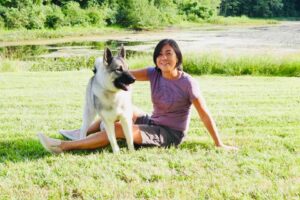
Kathi Molloy | Highpoint Norwegian Elkhounds
Kathi Molloy is the breeder behind Highpoint Norwegian Elkhounds. Read about the kennel’s beginnings, the dogs, the puppies, and more!
Home » Dog Breeds » Norwegian Elkhound Dog Breed
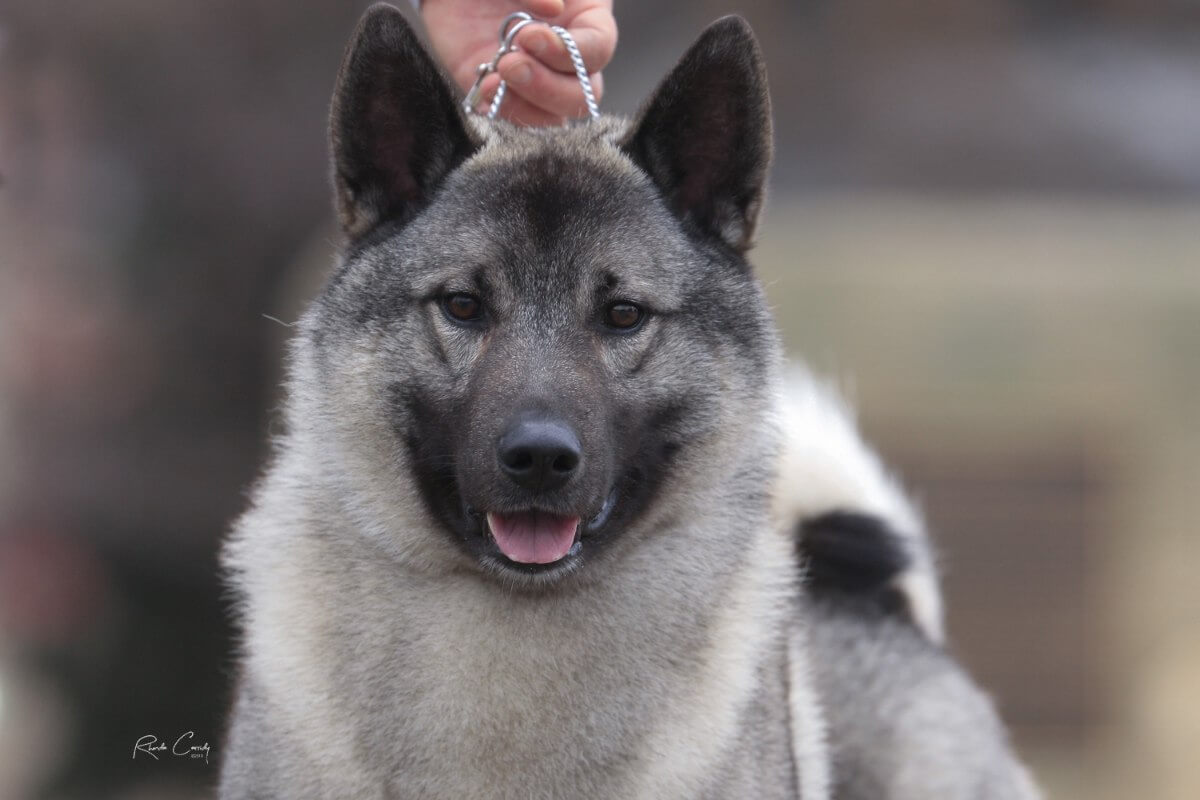
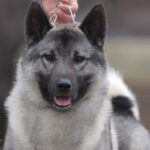
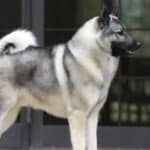
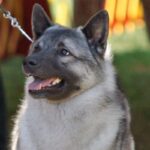
The Norwegian Elkhound, or simply Elkhound, stands among Europe’s oldest breeds of dog. This spitz-type canine is known for its rather wolf-like appearance and robust build. The breed’s name is somewhat of a misnomer, however, as the Elkhound was never intended to hunt elk. Even today, they are not considered a genuine hound. In Norwegian, “elg” means moose and “hund” means dog. So, the Elkhound is really a “moose dog.” Whatever its name, the breed can make for a wonderful watchdog and a beloved family companion.
Hound
19.5 – 20.5 Inches
48 – 55 Pounds
12 – 15 Years
| Country of Origin | Norway |
|---|---|
| Bred For | Hunting, Companionship |
| Known For | Northern Appearance, Courage, Endurance |
| Popularity | Low to Moderate |
| Temperament | Bold, Energetic, Independent |
| Activities | Hunting, Running, Hiking, Watchdog, Conformation Shows, Dog Sports |
The beautiful and rocky regions of Norway are home to the Norwegian Elkhound. The breed dates from about a millennium ago to a time when the Vikings used a sizeable and comparable dog for hunting and protection. Archaeologists have discovered skeletons of dogs that closely resemble the Elkhound in size and shape among artifacts from a primitive culture, suggesting that the breed may date back as far as 5,000 BCE. Although its exact history is lost in time, there is no doubt that the breed is inextricably linked to the area’s early human civilizations.
Norwegian Elkhounds are categorized as hounds despite having a very different appearance from the scenthounds and sighthounds that originated in warmer climates. The Elkhound has been used to protect herds, flocks, and homes as well as for hunting large animals such as bears and moose. The breed’s usefulness as hunter was due to its ability to track down prey by following its scent and then keep it at bay by barking until the hunter arrived.
Following the first dog exhibition organized by the Norwegian Hunters Association in 1877, the Norwegian Elkhound gained popularity as a breed. Local breeders soon started working to establish a written Breed Standard, maintain breed data, and develop the Elkhound as a competitive contender in the Conformation arena. In addition to being an excellent family companion, the modern breed excels in a wide range of canine sports and occupations, including Tracking, Guarding, Herding, Sledding, Agility, Obedience, Flyball, and Canine Freestyle. Norwegian Elkhounds are still employed as hunting dogs too, just as they were in the past.
Mature male Norwegian Elkhounds typically stand around 20.5 inches at the shoulder, while females usually measure around 19.5 inches.
Norwegian Elkhound males typically weigh around 55 pounds, with females averaging about 48 pounds in weight.
The Norwegian Elkhound is a typical spitz breed that displays a square profile and compact build, medium in both size and substance. A muscular neck, straight topline, and short body contribute to the breed’s strength and are collectively considered essential characteristics of the breed. The Elkhound’s size allows the dog to do its job perfectly, and its construction allows for movement that is light and effortless.
Texture: The undercoat is soft, dense, and wooly, while the outer coat is coarse and straight. The Norwegian Elkhound’s coat is typical of most Northern dog breeds, with thick, protective guard hairs and a soft, dense undercoat for insulation. This double coat is weather-resistant by virtue of it being thick, hard, and smooth-lying. On the head, ears, and fronts of the legs, the coat is short and even, but it is longer on the back of the neck, buttocks, and underside of the tail.
| Standard Color | |
|---|---|
| Gray Black & Silver | ee |
| Silver Gray & Black | ee |
| Gray & Black | ee |
| Silver & Black | ee |
| Black White & Silver | ee |
| Black & Gray | ee |
| Black & Silver | ee |
Markings: Variations Shadings
A Note About Color: Although generally gray in color, the Norwegian Elkhound’s coat displays variations in shade due to the length and quantity of the guard hair’s black tips. The body is darkest on the back (saddle) and lighter on the chest, mane, and from the shoulder to the elbow (harness). The muzzle, ears, and tip of the tail are black, and black hairs on the muzzle fade to lighter gray on the forehead and skull. “Sooty” coloration, irregular markings, white patches, and yellow or brown shading are not acceptable in the breed. Likewise, red, brown, white, solid black or any other solid color are unacceptable.
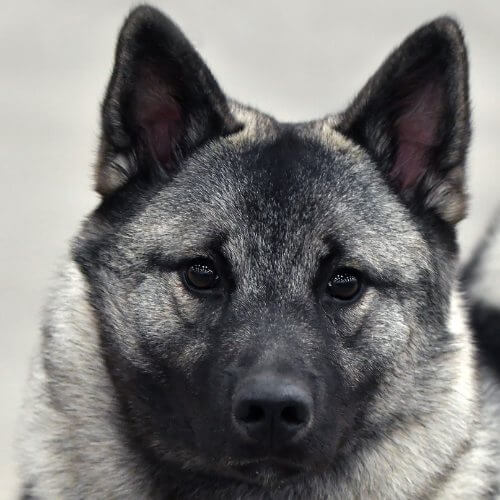
The Tail of a Norwegian Elkhound is always set high, tightly curled, and carried over the centerline of the back, making for a slightly different appearance than many of its Northern cousins. The tail is thick and closely haired, without the “brush” found on similar spitz breeds. The tail is always left natural and is never trimmed.
When considering a Norwegian Elkhound for the home, it’s important to understand the breed’s characteristics, needs, and temperament. By being highly adaptable and affectionate, this breed can be a great choice for both experienced pet owners and novices, the most important consideration is providing plenty of exercises to fulfill the breed’s high-energy needs. The Elkhound is an intelligent, bold, energetic, and protective breed and makes an ideal guardian. Before acquiring the breed, however, it’s essential to consider the fact that the Elkhound is known for barking and is not a great choice for apartment living.
The Norwegian Elkhound is typically healthy, however, the breed is prone to some health issues, as are all breeds and mixed breeds. Of course, not all Elkhounds will get any or all of these diseases, but it is essential to be aware of them. And it is important to remember that regular veterinary check-ups and a balanced diet can go a long way toward ensuring the well-being and longevity of any dog.
Lifespan: The average lifespan of a Norwegian Elkhound ranges between 12 and 15 years, but with proper care, regular exercise, and a balanced diet, many can thrive beyond these years.
While the Norwegian Elkhound is generally a healthy breed, it is not immune to certain health conditions. Some of the more common issues seen in the breed include:
The Norwegian Elkhound traces its roots back to ancient times when the dogs were shipmates of the Vikings. Today, this tough and tenacious breed can make a wonderful companion to people from all walks of life. It is a highly extroverted character and loves to be around the action. As is typical of active and independent breeds, it should be noted, this one can be a challenge to train.
Elkhounds are highly devoted to the family and are generally protective, and sometimes, even possessive. Yet, these characteristics make for a wonderful guardian. These dogs are loyal and devoted, but many have the need to be the center of attention most of the time.
Barking is one of the more notable characteristics of the Norwegian Elkhound. The breed can provide a level of security and is a natural watchdog, especially since it enjoy making vocalizations. It is not, however, an inherently aggressive dog. Any excessive barking can often be quieted through training, although it is best to avoid keeping this breed in an apartment.
The Elkhound loves to play a lot, but usually not with toys. Chasing balls (but not bringing them back) is one of its favorite activities. The breed is naturally adventurous and needs plenty of space to run around. So, all exercise should take place outdoors. Otherwise, most of the household belongings could get tossed and turned.
Overall, the Norwegian Elkhound is a loving dog that makes a fantastic family member in the right setting. These Nordic originals are naturally suspicious of strangers and make excellent watchdogs, but they thrive on attention and are typically great with kids. In fact, a more devoted canine companion might be pretty hard to find.
The Norwegian Elkhound should thrive on high-quality food, whether purchased commercially or prepared at home with a veterinarian’s supervision. The diet should be high in protein, moderate in fat, and low in carbohydrates, and it can sometimes be best to feed a raw food diet. Elkhounds can be “food hounds,” so it is important to supervise what the dog eats.
The diet should be tailored to the age of the dog (puppy, adult, or senior), as well as its size, build, metabolism, and activity level. Highly active dogs will need more food than those that are less active.
When it comes to feeding an Elkhound puppy, a nutrient-rich diet that promotes steady growth and development is crucial. A pup’s dietary requirements will change as it reaches adulthood, when the recommended amount of food will be 2 to 2.5 cups per day.
Better quality food will nourish a dog best, so less food will be needed. Meals should be measured and split it into two servings per day rather than one. Also, it’s important to never leave food out all day and avoid feeding human food.
It is essential to monitor a Norwegian Elkhound’s weight to avoid overfeeding. The main indication that a dog is overweight is a rolling motion of its back or sides when the dog trots.
Another important consideration is to always have fresh water readily available for the Norwegian Elkhound. Hydration is just as crucial as nutrition, and this is especially so for such an active breed.
The Norwegian Elkhound is an independent and stubborn breed that can occasionally make training a bit difficult. The journey of training one of these beautiful hounds requires patience, consistency, and an understanding of the breed’s true nature.
Elkhounds are intelligent, so they can easily pick up commands. On the other hand, they want something in return for the obedience work. Treats can be a good reward, but so is the owner’s praise. Once the Elkhound gets attached to its favorite person, the bond is inseparable.
This Elkhound is naturally dominant, so it needs a firm handler for training. Owners of this breed should represent the pack leader as it is the only way for the dog to follow commands and take the training seriously. Otherwise, training can be difficult and the Elkhound will want to take the lead.
The Norwegian Elkhound should be provided with plenty of outdoor space. With its hunting heritage, the breed is highly adventurous and enjoys running and chasing whatever it perceives as prey. Some have even been known to catch game on their own. Elkhounds prefer a winter climate with lots of snow, but if this is not possible, most can happily exercise in warmer environments provided there’s a change-up to their daily routine.
In general, a Norwegian Elkhound’s daily activity should be vigorous. This breed can become irritable if it does not get enough mental and/or physical exercise. And when walking this breed, it’s best to have the dog heel beside or behind the handler, never in front, to reaffirm the owner’s position of authority.
The Norwegian Elkhound has a weather-resistant coat that provides insulation in all types of temperatures. However, the breed’s double coat sheds two to three times a year and requires regular grooming to keep it looking its best.
| Coat Type | Thick, Hard, Weather-Resistant, Smooth |
|---|---|
| Grooming Requirements | Weekly Brushing, Occasional Bathing, Routine Ear Cleaning, Periodic Nail Trimming, Regular Tooth Brushing |
The Norwegian Elkhound’s coat is short and thick, with an undercoat that’s dense, wooly, and soft. The breed is always found in its natural state, with no trimming needed. Many Elkhounds can be prone to skin problems when they are trimmed or even shaved, and a haircut typically damages the guard hairs and causes them to grow improperly.
Elkhounds are a naturally clean breed in terms of their coat, which tends to expel debris on its own. Weekly brushing is needed when the dog isn’t shedding its coat, but daily brushing is often required during shedding seasons.
Luckily, Norwegian Elkhounds don’t typically have a doggy odor, so bathing is not required too frequently. Instead, it should be necessary only when the dog has rolled in something stinky. In that case, bathing should be done with a high-quality shampoo to protect the skin and coat.
Beyond coat care, other grooming tasks include brushing the Elkhound’s teeth two to three times a week to remove tartar build-up and bacteria. To prevent gum disease and bad breath, it is better to do the daily brushing if possible. Trimming the nails should be done once or twice a month if the dog doesn’t wear them down naturally, and ears should be also checked and cleaned weekly.
Living with a Norwegian Elkhound is a rewarding experience considering the breed’s protectiveness, adaptability, and most importantly, its wonderful sense of adventure. The breed is highly adaptable and enjoys accompanying its family on any kind of outdoor adventure. Elkhounds love cold weather and definitely enjoy playing in the snow; however, swimming can also be a good option for fulfilling their high-energy needs.
Training is essential for an Elkhound, although it can be a challenge due to the breed’s often stubborn and dominant nature. It is important, therefore, to be firm and consistent when training and to reinforce that the dog is not the one in charge. Conversely, the breed is highly affectionate towards its family members and usually makes an outgoing, if protective, companion.
Since the Elkhound is a highly vocal breed, these dogs can bark at anything and everything, even if there’s nothing to bark at! And although it is not a good choice for an apartment dog, an Elkhound can live in a smaller space without barking excessively if it is given enough time outdoors and plenty of mental stimulation.
Despite the breed’s wolf-like appearance, the Norwegian Elkhound is far from intimidating. On the contrary, most Elkhounds are known to be friendly and sweet. When they are not active, their favorite activity is to cuddle with their owner. Most are great around children of all ages, although interactions with kids and dogs should always be supervised.
The Norwegian Elkhound tends to be a highly protective dog, so it is important to socialize puppies when they’re young and introduce them to as many people as possible as they mature. Introducing the Elkhound to other dogs is also important, since the breed is not always polite during these introductions.
Norwegian Elkhound puppies bring joy and happiness to most any home with their energy, playfulness, and friendliness. However, the stubborn side of the breed shows at a young age and requires a lot of patience and responsibility for their caretakers. Still, raising these puppies is always a fun journey – no matter what.
When bringing a Norwegian Elkhound puppy home, it can be easy to think that it’s a shy and calm breed. However, once the puppy has adapted to its surroundings and meets its own people, a whole new story begins. The Elkhound puppy is, indeed, active, curious, playful, and most of all, stubborn.
Nutrition is one of the first things to think about. A puppy grows quickly and its diet should keep up with its growth. A high-quality puppy food that is rich in critical nutrients and designed specifically for medium and large breed puppies is needed. The amount and frequency of meals can be guided by the feeding guidelines published on pet food packaging or by a veterinarian’s advice.
Socialization is the second important aspect of a puppy’s life. With the Elkhound being a protective breed and not necessarily good with other dogs, it is of great importance to start introducing the new puppy to different dogs and people. New introductions help to shape a pup’s temperament and its behavior as an adult.
Training should begin as soon as possible, taking advantage of a puppy’s adaptable nature. While the Elkhound puppy is intelligent, the breed’s stubbornness can make training difficult at times. Positive reinforcement strategies, such as using treats, praise, and toys, are the most effective.
Because of its curious temperament, the Norwegian Elkhound puppy will want to explore every corner and crevice of its new home. The living space must therefore be puppy-proofed. In the early weeks and months, it is critical to maintain a healthy environment that is free of dangerous substances and choking hazards.
Norwegian Elkhound owners understand that their dogs are high-energy canines that require a lot of exercise to keep them from climbing the walls. Aside from daily walks, it is critical to engage these dogs in a variety of activities.
The Norwegian Elkhound is recognized by the world’s leading registries and kennel organizations, which categorize the breed into a specific Group based on its unique characteristics. This breed is recognized worldwide under the following Group designations:
| Organization | Group Designation |
|---|---|
| AKC (American Kennel Club) | Hound |
| UKC (United Kennel Club) | Northern Breed |
| CKC (Canadian Kennel Club) | Hounds |
| ANKC (Australian National Kennel Council) | Hounds |
| RKC (The Royal Kennel Club) | Hound |
| FCI (Fédération Cynologique Internationale) | Group 5: Spitz and Primitive Types; Section 2: Nordic Hunting Dogs |
The ideal Norwegian Elkhound is described by a Breed Standard that is approved by each of the world’s leading registries and kennel organizations. The Breed Standards for this breed may be found in the following links:
| Organization | Breed Standard |
|---|---|
| American Kennel Club | AKC Norwegian Elkhound Breed Standard |
| United Kennel Club | UKC Norwegian Elkhound Breed Standard |
| Canadian Kennel Club | CKC Norwegian Elkhound Breed Standard |
| Australian National Kennel Council | ANKC Norwegian Elkhound Breed Standard |
| The Royal Kennel Club | RKC Norwegian Elkhound Breed Standard |
| Fédération Cynologique Internationale | FCI Norwegian Elkhound Breed Standard |
Norwegian Elkhound clubs are indispensable in preserving the breed’s Standards, promoting responsible breeding practices, and fostering a supportive community for enthusiasts and breeders alike. These organizations often serve as hubs for education, social events, and advocacy for the Norwegian Elkhound as a recognized breed.
In the United States, the primary organization dedicated to the Norwegian Elkhound is the Norwegian Elkhound Association of America (NEAA). The NEAA is committed to safeguarding the breed’s written Breed Standard, advocating for responsible breeding practices, and providing educational resources for both owners and judges of the breed.
The Norwegian Elkhound Club of Canada takes a leading role in promoting the breed in Canada. The NECC offers competitive events, educational resources, and networking opportunities for Canadian Elkhound lovers.
In the United Kingdom, the Norwegian Elkhound Club of Great Britain is dedicated to promoting the breed. It was founded in 1923 as the British Elkhound Society, though it was later renamed.
Joining or engaging with these and similar clubs provides Norwegian Elkhound enthusiasts with a wealth of knowledge and opportunities to connect with others who share the same passion for this iconic breed.
If purchased without previous knowledge of the breed, a Norwegian Elkhound can end up in need of adoption or foster care.
Norwegian Elkhound Rescue is the leading rescue group in Canada, operating under the broader umbrella of the Norwegian Elkhound Club of Canada.
In the United Kingdom, the most popular organization to aid Elkhounds in need is the Elkhound Rescue Fund. Besides finding homes for abandoned or neglected dogs, this group also takes care of dogs whose owners can no longer take care of them for any reason.
Yes, Norwegian Elkhounds are known to shed a significant amount. They have a dense, double coat that sheds throughout the year, with increased shedding during seasonal changes. Regular grooming can help to manage the shedding, but potential owners should be prepared for a considerable amount of hair in their homes.
Norwegian Elkhounds are medium-sized dogs, with males typically weighing around 55 pounds and standing 20.5 inches at the shoulder. Females are slightly smaller, usually weighing around 48 pounds and measuring 19.5 inches tall. The breed’s sturdy and compact build makes these dogs well-suited for endurance and agility activities.
Norwegian Elkhounds are not inherently aggressive, but they do have a strong protective instinct. They were originally bred for hunting large game, such as elk and bears, which has ingrained a fearless and resilient nature in the breed. With proper training and socialization, they are known to be friendly and good-natured, though they can be reserved around strangers.
Norwegian Elkhounds are intelligent and eager to please, which can make them relatively easy to train. However, they also have a strong-willed and independent nature, which may require consistent and patient training methods. Positive reinforcement and early socialization are key to successfully training a Norwegian Elkhound.
Norwegian Elkhounds are not considered endangered. They are a popular breed in their native Norway and have a steady population in other parts of the world as well. However, like all breeds, responsible breeding practices are important to ensure the health and longevity of the breed.
Norwegian Elkhounds can make excellent family pets. They are known for their loyalty and affection towards their family, and they generally get along well with children. However, due to their hunting background, they may have a strong prey drive, so interactions with small pets should be supervised.
Yes, Norwegian Elkhounds can make good guard dogs. Their protective nature and strong bark make them excellent watchdogs. They are also very loyal to their family and will not hesitate to defend their home if they perceive a threat.
The interaction between Norwegian Elkhounds and cats can vary depending on the individual dog. Some Elkhounds will live peaceably with cats, especially if they are raised together. However, the breed’s strong prey drive can trigger a chase response, so introductions should be done carefully and supervision is recommended.
Norwegian Elkhounds are not considered hypoallergenic. They have a dense double coat that sheds a considerable amount, and they produce dander, both of which can trigger allergies in sensitive individuals. Potential owners with allergies should spend time around the breed before making a commitment.
While Norwegian Elkhounds are not as common as some other breeds, they are not considered rare. They have a stable population, especially in their native Norway and in other parts of Scandinavia. They are also present and recognized in many other countries around the world.
Yes, Norwegian Elkhounds are known to be intelligent and quick learners. They have a history as a hunting dog, which requires the ability to make quick decisions and work independently. This intelligence, combined with the breed’s eagerness to please, makes them responsive to training.
Norwegian Elkhounds are capable swimmers, and many of them enjoy water and swimming activities. However, individual preferences can vary, and not all Elkhounds may be inclined to swim. Proper introduction to water and safety measures should be taken when allowing an Elkhound to swim.
Norwegian Elkhounds are known for their strong and powerful bark, which they use to communicate and to alert their owners. They can be quite vocal, especially if they sense something unusual or if they are not properly stimulated. Proper training and mental engagement can help to manage any excessive barking.

Kathi Molloy is the breeder behind Highpoint Norwegian Elkhounds. Read about the kennel’s beginnings, the dogs, the puppies, and more!
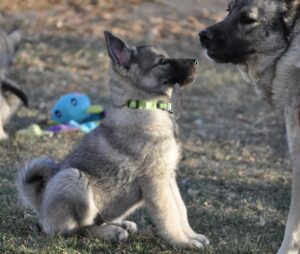
Robin Rhoden is the breeder behind the Aspen Norwegian Elkhounds. Read about the kennel’s beginnings, the puppies, and much more!
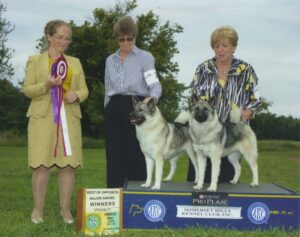
Interview with 2022 AKC Hound Group Honoree, Margaret “Maggie” K. Mott and Sally P. Simmonds of Kamgaard Norwegian Elkhounds.
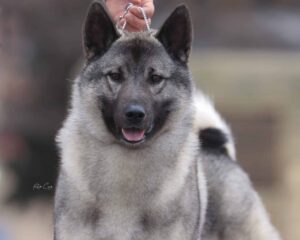
The Norwegian Elkhound is a hardy gray hunting dog. These are the first words of the Official Standard. Any prospective breeder or judge

Kathi Molloy is the breeder behind Highpoint Norwegian Elkhounds. Read about the kennel’s beginnings, the dogs, the puppies, and more!

Robin Rhoden is the breeder behind the Aspen Norwegian Elkhounds. Read about the kennel’s beginnings, the puppies, and much more!

Interview with 2022 AKC Hound Group Honoree, Margaret “Maggie” K. Mott and Sally P. Simmonds of Kamgaard Norwegian Elkhounds.

The Norwegian Elkhound is a hardy gray hunting dog. These are the first words of the Official Standard. Any prospective breeder or judge
The best way to ensure a long and happy relationship with a purebred dog is to purchase one from a responsible breeder. Not sure where to begin?
Contact the National Parent Club’s Breeder Referral Program, which is listed on the AKC Breeder Referral Contacts page.
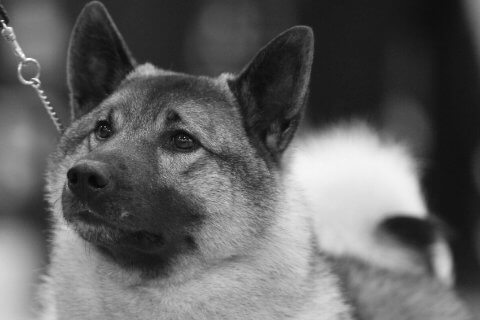

"*" indicates required fields
Showsight Magazine–the world’s most influential purebred dog publication since 1992. Each issue reaches a global audience dedicated to preserving the history and health of purpose bred dogs. Filled with award-winning editorial focused on news and insights from the dog show community, top breeders, handlers, AKC Judges, and more!